Charles Duke
Charles Moss Duke Jr. (born October 3, 1935) is an American former astronaut, U.S. Air Force (USAF) officer and test pilot. As lunar module pilot of Apollo 16 in 1972, he became the tenth (and as of 2021 remains) and youngest person to walk on the Moon, at age 36 years and 201 days.
Charles M. Duke Jr. | |
|---|---|
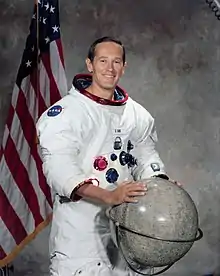 Duke in September 1971 | |
| Born | Charles Moss Duke Jr. October 3, 1935 |
| Status | Retired |
| Nationality | American |
| Alma mater | |
| Occupation | Fighter pilot, test pilot |
| Awards | |
| Space career | |
| NASA Astronaut | |
| Rank | |
Time in space | 11d 01h 51m |
| Selection | 1966 NASA Group 5 |
Total EVAs | 3 |
Total EVA time | 21 hours 38 minutes |
| Missions | Apollo 16 |
Mission insignia | 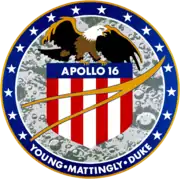 |
| Retirement | January 1, 1976 |
| Website | www |
A 1957 graduate of the United States Naval Academy, he joined the USAF. He completed advanced flight training on the F-86 Sabre at Moody Air Force Base in Georgia, where he was a distinguished graduate. After completion of this training, Duke served three years as a fighter pilot with the 526th Fighter-Interceptor Squadron at Ramstein Air Base in West Germany. After graduating from the Aerospace Research Pilot School in September 1965, he stayed on as an instructor teaching control systems and flying in the F-101 Voodoo, F-104 Starfighter, and T-33 Shooting Star.
In April 1966, Duke was one of nineteen men selected for NASA's fifth group of astronauts. In 1969, he was a member of the astronaut support crew for Apollo 10. He served as CAPCOM for Apollo 11, the first crewed landing on the Moon. His distinctive Southern drawl became familiar to audiences around the world, as the voice of a Mission Control made nervous by a long landing that almost expended all of the Lunar Module Eagle's fuel. Duke's first words to the Apollo 11 crew on the surface of the Moon were flustered, "Roger, Twank...Tranquility, we copy you on the ground. You got a bunch of guys about to turn blue. We're breathing again. Thanks a lot!"
Duke was backup lunar module pilot on Apollo 13. Shortly before the mission, he caught rubella (German measles) from a friend's child and inadvertently exposed the prime crew to the disease. As Ken Mattingly had no natural immunity to the disease, he was replaced as command module pilot by Jack Swigert. Mattingly was reassigned as command module pilot of Duke's flight, Apollo 16. On this mission, Duke and John Young landed at the Descartes Highlands, and conducted three extravehicular activities (EVAs). He also served as backup lunar module pilot for Apollo 17. Duke retired from NASA on January 1, 1976.
Following his retirement from NASA, Duke entered the Air Force Reserve and served as a mobilization augmentee to the Commander, USAF Basic Military Training Center, and to the Commander, USAF Recruiting Service. He graduated from the Industrial College of the Armed Forces in 1978. He was promoted to brigadier general in 1979, and retired in June 1986. He has logged 4,147 hours' flying time, of which 3,632 hours is in jet aircraft, and 265 hours in space, including 21 hours and 38 minutes of EVA.
Charlie resides in New Braunfels, Texas, and was named Texan of the Year in 2020. He is presently on the board of directors for the Astronaut Scholarship Foundation and previously served for two years as the chairman. He is a popular motivational speaker, with NASA films and personal stories of his Apollo mission on the moon. He is a born again Christian and he and his wife, Dorothy, travel and share their faith and how God restored their marriage.
Early life and education
Charles Moss Duke Jr. was born in Charlotte, North Carolina,[1] on October 3, 1935,[2] the son of Charles Moss Duke, an insurance salesman, and his wife Willie Catherine, née Waters, who worked as a buyer for Best & Co.[3][4] He was followed six minutes later by his identical twin brother William Waters (Bill) Duke.[3] His mother traced her ancestry back to Colonel Philemon Berry Waters, who fought in the American Revolutionary War.[2]
After the Japanese attack on Pearl Harbor on December 7, 1941, brought the United States into World War II, his father volunteered to join the Navy, and was assigned to Naval Air Station North Island in California. The family moved to California to join him, but after a year he was shipped out to the South Pacific, and Willie took the boys to Johnston, South Carolina, where her mother lived.[3] His father returned from the South Pacific in 1944, and was stationed at Naval Air Station Daytona Beach, so the family moved there. In 1946, after the war ended, they settled in Lancaster, South Carolina,[5] where his father sold insurance, and his mother ran a dress shop.[6] A sister, Elizabeth (Betsy), was born in 1949.[7]
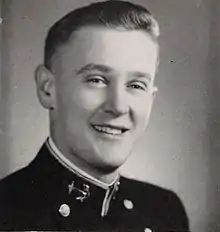
As a boy, Duke and his brother Bill made model aircraft. A congenital heart defect caused Bill to drop out of strenuous sports, and eventually inspired him to pursue a career in medicine, but golf was a sport that they enjoyed together.[8] Duke was active in the Boy Scouts of America and earned its highest rank, Eagle Scout in 1946.[9][10] He attended Lancaster High School. Duke decided that he would like to pursue a military career. Since his father had served in the Navy, he wanted to go to the United States Naval Academy in Annapolis, Maryland.[11]
As a first step, Duke went to see his local congressman, James P. Richards, who lived in Lancaster. Richards said that he would be pleased to give Duke his nomination, as a local boy. Richards advised Duke that he would still need to pass the entrance examination, and recommended that he attend a military prep school. Duke and his parents accepted this advice, and chose the Admiral Farragut Academy in St. Petersburg, Florida, for his final two years of schooling. Duke sat the examination for Annapolis in the middle of his senior year, and soon after received a letter informing him that he had passed, and had been accepted into the class of 1957. The Lancaster News ran his picture on the front page along with the announcement of his acceptance. He graduated from Farragut as valedictorian and president of the senior class in 1953.[11]
Duke entered the Naval Academy in June 1953. He was no athlete, but played golf for the academy team. During a two-month summer cruise to Europe on the escort carrier USS Siboney, he suffered from seasickness, and began questioning his decision to join the Navy. On the other hand, he greatly enjoyed a familiarization flight in an N3N seaplane, and began thinking of a career in aviation. The United States Air Force Academy had just been established and would not graduate its first class until 1959, so up to a quarter of the Annapolis class were permitted to volunteer for the United States Air Force. In fact, more than a quarter of the class of 1957 did so, and names were drawn from a hat. At his commissioning physical, Duke was shocked to find that he had a minor astigmatism in his right eye, which precluded becoming a naval aviator, but the Air Force said that it would still take him. He received a Bachelor of Science degree in naval sciences in June 1957, and was commissioned as a second lieutenant in the Air Force.[12]
Air Force
In July 1957, Duke, along with the other graduates of Annapolis and West Point who had chosen the Air Force, reported to Maxwell Air Force Base in Montgomery, Alabama, for two weeks' orientation. He was then sent to Spence Air Force Base in Moultrie, Georgia, for primary flight training. The first three months involved classwork and training with the T-34 Mentor, while the next three were with the T-28 Trojan; both were propeller-driven aircraft. For the next phase of his training, he went to Webb Air Force Base in Big Spring, Texas, in March 1958 for training with the T-33 Shooting Star, a jet aircraft. He graduated near the top of his class, and received his wings and a certificate identifying him as a distinguished graduate, which gave him a choice of assignments. He chose to become a fighter pilot. He completed six months' advanced training on the F-86 Sabre aircraft at Moody Air Force Base in Valdosta, Georgia, where he was also a distinguished graduate.[13]
_Test_Pilot_School_(TPS)_Class_64C.jpg.webp)
Once again, Duke had his choice of assignments, and chose the 526th Fighter-Interceptor Squadron at Ramstein Air Base in West Germany. This was at the height of the Cold War, and tensions ran high, especially during the Berlin Crisis of 1961. Duke chose the assignment precisely because it was the front line. Four of the 526th's F-86 (and later F-102 Delta Dagger) fighter-interceptors were always on alert, ready to scramble and intercept aircraft crossing the border from East Germany.[14]
As his three-year tour of duty in Europe came to an end, Duke considered that his best career option was to further his education, something that the USAF was encouraging. He applied to study aeronautical engineering at North Carolina State University, but this was not available. Instead he was offered a place at the Massachusetts Institute of Technology (MIT) in its Master of Science degree course in aeronautics and astronautics. He entered MIT in June 1962.[14]
It was in Boston that he met Dotty Meade Claiborne,[15][16] a graduate of Hollins College and the University of North Carolina,[17] who had recently returned from a summer trip to Europe. They became engaged on Christmas Day, 1962, and were married by her uncle, Randolph Claiborne, the bishop of the Episcopal Diocese of Atlanta, in the Cathedral of Saint Philip,[16] on June 1, 1963.[2] They went to Jamaica for their honeymoon, but came down with food poisoning.[18]
While he was courting Dotty, Duke's grades had slipped, and he was placed on scholastic probation, but the USAF allowed him to enroll for another term.[18] For his dissertation, Duke teamed up with a classmate, Mike Jones, to perform statistical analysis for the Project Apollo guidance systems. As part of this work, they got to meet astronaut Charles Bassett. Their work earned them an A, bringing his average up to the required B, and he was awarded his Master of Science degree in May 1964.[19]
For his next assignment, Duke applied for the USAF Aerospace Research Pilot School (ARPS), although he felt his chances of admission were slim given that he only barely met the minimum qualification. Nonetheless, orders came through for him to attend class 64-C, which commenced in August 1964 at Edwards Air Force Base in California. The commandant at the time was Chuck Yeager,[20] and Duke's twelve-member class included Spence M. Armstrong, Al Worden, Stuart Roosa and Hank Hartsfield.[21] Peter Hoag topped the class; Duke tied for second place.[22] After graduating from ARPS in September 1965, Duke stayed on as an instructor teaching control systems and flying in the F-101 Voodoo, F-104 Starfighter, and T-33 Shooting Star aircraft.[21] While he was stationed at Edwards, his first child, Charles Moss Duke III, was born at the base hospital in March 1965.[23]
NASA
Selection and training
On September 10, 1965, NASA announced that it was recruiting a fifth group of astronauts.[24] Duke spotted a front-page article in the Los Angeles Times, and realized that he met all the requirements. He went to see Yeager and the deputy commandant, Colonel Robert Buchanan, who informed him that there were two astronaut selections in progress: one for NASA, and one for the USAF's Manned Orbiting Laboratory (MOL) program.[25] Nominations to NASA had to come through Air Force channels, so it got to pre-screen them. Buchanan told Duke that he could apply for both programs, but if he did, MOL would take him. Duke applied only to NASA, as did Roosa and Worden;[26] Hartsfield applied for both and was taken by MOL.[27]
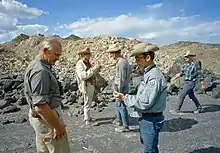
Duke made the list of 44 finalists selected to undergo medical examinations at Brooks Air Force Base at San Antonio, Texas. He arrived there on January 26, 1966, along with two fellow aviators from Edwards, Joe Engle and Bill Pogue.[26] Psychological tests included Rorschach tests; physical ones included encephalograms, and sessions on treadmills and in a human centrifuge.[28] The eye problem that the Naval Academy had reported was not found.[29]
The final stage of the selection process was an interview by the seven-member selection panel. This was chaired by Deke Slayton, with the other members being astronauts Alan Shepard, John Young, Michael Collins and C.C. Williams, NASA test pilot Warren North, and spacecraft designer Max Faget. These were conducted over a week at the Rice Hotel in Houston.[28][30] In April 1966, a phone call from Slayton informed Duke that he had been selected.[29] NASA officially announced the names of the 19 men selected on April 4, 1966.[31] Young named the group the "Original Nineteen" in a parody of the original Mercury Seven astronauts.[32]
Duke and his family moved to an apartment in League City, Texas, but when Dotty became pregnant again, they bought a vacant lot in El Lago, Texas, next door to astronaut Bill Anders. They met and befriended a young couple, Glenn and Suzanne House. Glenn was an architect, and he agreed to design them a house for $300.[33] Ground was broken in February 1967, but the house was not completed before a second son, Thomas, was born in May.[34]
Astronaut training included four months of studies covering subjects such as astronomy, orbital mechanics and spacecraft systems.[33] Some 30 hours of briefings were conducted on the Apollo command and service module, and twelve on the Apollo lunar module.[35] An important feature was training in geology, so that astronauts on the Moon would know what rocks to look out for. This training in geology included field trips to the Grand Canyon and the Meteor Crater in Arizona, Philmont Scout Ranch in New Mexico, Horse Lava Tube System in Bend, Oregon, and the ash flow in the Marathon Uplift in Texas, and other locations, including Alaska and Hawaii.[36] There was also jungle survival training in Panama, and desert survival training around Reno, Nevada. Water survival training was conducted at Naval Air Station Pensacola using the Dilbert Dunker.[37]
Once their initial training was complete, Duke and Roosa were assigned to oversee the development of the Saturn V launch vehicle, as part of the Booster Branch of the Astronaut Office, headed by Frank Borman and C.C. Williams.[38] He was part of the Mission Control team at the Kennedy Space Center that monitored the launch of Gemini 11 on September 12, 1966, and Gemini 12 on November 11, 1966. His personal responsibility was the Titan II booster.[39][40] They frequently traveled to Marshall Space Flight Center in Huntsville, Alabama, to confer with its director, Wernher von Braun.[41] NASA provided T-38 Talon aircraft for the astronauts' use, and like most astronauts, Duke flew at every opportunity.[34]
Lunar module specialist
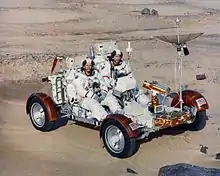
The Nineteen were divided into command and service module (CSM) and lunar module (LM) specialists. Slayton asked each of them which speciality he preferred, but made the final decision himself. Once again, Duke received his choice, and became a lunar module specialist.[42] He oversaw the development of the lunar module propulsion systems. A major concern was the ascent propulsion system, which was a critical component of the mission that had to work for the astronauts to survive.[43] Testing at the White Sands Missile Range in 1966 indicated combustion instability.[44] George Low, the Apollo Spacecraft Program manager, convened a committee to review the situation, and Duke became the Astronaut Office representative on it.[43] Although Bell was confident that it could resolve the problems, NASA hired Rocketdyne to develop an alternative engine just in case. The committee ultimately decided to use Rocketdyne's injector system with Bell's engine.[45]
In 1969, Duke became a member of the support crew for Apollo 10, along with Joe Engle and Jim Irwin.[46] During Projects Mercury and Gemini, each mission had a prime and a backup crew. For Apollo, a third crew of astronauts was added, known as the support crew. The support crew maintained the flight plan, checklists and mission ground rules, and ensured the prime and backup crews were apprised of changes. They developed procedures, especially those for emergency situations, so these were ready for when the prime and backup crews came to train in the simulators, allowing them to concentrate on practicing and mastering them.[47] The mission commander, Tom Stafford, selected Duke for his familiarity with the LM, especially its propulsion systems.[41] For this reason, Duke served as CAPCOM for the LM orbit, activation, checkout, and rendezvous on Apollo 10.[43][48]
It was unusual for someone to serve as CAPCOM on back-to-back missions, but for the same reason—familiarity with the LM—Neil Armstrong, the commander of Apollo 11, asked Duke to reprise his role on that mission, which included the first crewed landing on the Moon. Duke told Armstrong that he would be honored to do so.[43] Duke's distinctive Southern drawl became familiar to audiences around the world, as the voice of a Mission Control made nervous by a long landing that almost expended all of the LM Eagle's fuel. Duke's first words to the Apollo 11 crew on the surface of the Moon were flustered, "Roger, Twank...Tranquility, we copy you on the ground. You got a bunch of guys about to turn blue. We're breathing again. Thanks a lot!"[43]
Apollo 13
.jpg.webp)
The next rung on the ladder after serving on a support crew was to serve on a backup crew. The pace of the early Apollo missions meant that multiple crews had to be training at the same time. Slayton developed a rotation scheme whereby the backup crew for one mission would become the prime crew for one three missions later, and then the backup for the one three missions after that. If the commander (CDR) declined the offer of another mission, the command module pilot (CMP), as the next most senior astronaut, would become the commander (CDR). Thus, the Apollo 10 crew became the backup crew for Apollo 13. Tom Stafford accepted the position of acting Chief of the Astronaut Office, so the CMP, John Young, stepped up to replace him as CDR; Gene Cernan remained lunar module pilot (LMP), and Jack Swigert, a command module specialist from the Nineteen, was designated the CMP. The intention was that this crew would eventually become the prime crew for Apollo 16, but Cernan did not agree with this; he wanted to command his own mission. Slayton therefore assigned Duke, who was well known to Young from Apollo 10, in Cernan's place. After Michael Collins, the CMP of Apollo 11, turned down the offer of command of the backup crew of Apollo 14, Slayton gave this command to Cernan.[49][50][51]
Full-time training for Apollo 13 commenced in July 1969,[52] although the selection of the Apollo 13 and 14 crews was not officially announced until August 7.[53] The prime crew for Apollo 13 consisted of Jim Lovell (CDR), Fred Haise (LMP) and Ken Mattingly (CMP). The mission was originally scheduled to be flown in late 1969, but in view of the successful outcome of Apollo 11, it was postponed until March and then April 1970.[52] Two or three weeks before the launch date, Duke contracted rubella (German measles) from Paul House, the son of Glenn and Suzanne House. The disease is highly contagious, so the NASA doctors checked the prime crew. It was found that Lovell and Haise were immune to the disease, but Mattingly was not. The decision was taken to remove Mattingly and replace him with Swigert.[43]
The subsequent explosion on Apollo 13 greatly affected the backup crew, especially Mattingly, who felt that he should have been on board. Young, Mattingly and Duke worked in the simulators to develop emergency procedures for the crew, who were ultimately returned safely to Earth. Haise and Swigert teased Duke, calling him "Typhoid Mary". The measles incident resulted in procedures being changed; starting with Apollo 14, the crew would be quarantined for three weeks before the flight as well as afterward. In the event, only the Apollo 14 crew had to endure two periods of quarantine; with no signs of life on the Moon, the post-mission quarantine was discontinued in April 1971.[54][55][56]
Apollo 16
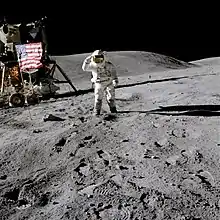
Duke, saluting the U.S. flag on the surface of the Moon, April 21, 1972.[57]
Training
Young, Mattingly and Duke were officially named as the crew of Apollo 16, the fifth lunar landing mission, on March 3, 1971.[58] The Descartes Highlands were chosen as the landing site on June 3, 1971. This was the highest region on the near side of the Moon. It was believed to be volcanic in origin and mainly composed of basalt, based upon the tones of gray observed from Earth. It was hoped that rock samples retrieved by Apollo 16 would provide clues about the processes that formed the highlands, and perhaps even show that such processes were still active.[59][60]
Training was conducted in the lunar module simulator, which used a TV camera and a scale model of the landing area. Other activities included driving a training version of the Lunar Roving Vehicle (LRV), and collecting geological samples. A final geological field trip was made to the big island of Hawaii in December 1971. On the second day of the trip, Duke caught the flu. By New Year's Day he was so ill that he was unable to get out of bed, and asked the Astronaut Office to send someone to take him to the doctor at the Kennedy Space Center. The doctor took an X-ray that revealed pneumonia in both lungs and called an ambulance to take Duke to the Patrick Air Force Base hospital.[61][62]
Duke feared that he might not recover in time for the launch, which was scheduled for March 17, 1972.[62] The spacecraft and Saturn V launch vehicle had already been rolled out to Launch Pad 39A on December 13.[63] Luck was with Duke: Grumman engineers wanted more time to test the increased capacity of the LM's batteries; a fault was found with the explosive cords that separate the LM from the CSM that warranted their replacement; and a failure of a clamp in Duke's spacesuit during training required the modification of all three astronauts' suits. This caused the launch date to be postponed to the next launch window, on April 16.[64][65] This proved fortunate when an error by launch pad technicians caused one of the CM's Teflon fuel tank bladders to rupture, and the entire space vehicle had to be returned to the Vehicle Assembly Building.[66][67] Slayton noted that "there wasn't even any discussion of replacing him; that was one of the lessons we'd learned on 13."[68]
The astronauts went into quarantine and were allowed out only to fly T-38s for an hour a day. The day before liftoff, the Apollo Program director, Rocco Petrone saw someone he thought was Duke around the pool at the Holiday Inn. A furious Petrone called the crew quarters demanding to know why Duke had broken quarantine. The staff's protestations that Duke was still there and had not left did not placate Petrone, and they had to track down Duke in training, who suggested that Petrone might have seen his brother Bill.[69] When Apollo 16 was launched at 12:54 Eastern Standard Time (17:54 UTC) on April 16, 1972,[70] Duke became the first twin to fly in space.[71]

Outbound voyage
The launch was normal; the crew experienced vibration similar to that of previous crews. The first and second stages of the Saturn V performed flawlessly, and the spacecraft entered low Earth orbit just under 12 minutes after liftoff. In Earth orbit, the crew faced minor technical issues, including a potential problem with the environmental control system and the S-IVB third stage's attitude control system, but these were resolved or compensated for. After 1.5 orbits, it reignited for just over five minutes, propelling the craft towards the Moon at 35,000 km/h (22,000 mph).[72][70]
In lunar orbit, the crew faced a series of problems. Duke was unable to get the S-band steerable antenna on the LM Orion to move in the yaw axis, and therefore could not align it correctly. This resulted in poor communications with the ground stations, and consequently a loss of the computer uplink. This meant that Duke had to copy down 35 five-digit numbers and enter them into the computer. Correcting any mistake was a complicated procedure. Fortunately, the astronauts could still hear Mission Control clearly, although the reverse was not the case.[73][74]
When Young went to activate the reaction control system, they suffered a double failure on the pressurization system.[73] Young described this as "the worst jam I was ever in".[75] A long debate between the astronauts and with Mission Control followed. It was the only time during the flight that Duke could recall arguing with Young.[73] Although they could not fix the problem, they were able to work around it by shifting propellant into the ascent storage tank. None was lost; it was just moved into another tank.[75]
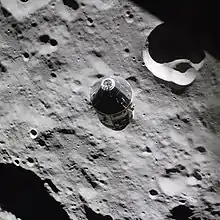
With the preparations finished, Young and Duke undocked Orion from Mattingly in the CSM Casper. Mattingly prepared to shift Casper to a circular orbit while Young and Duke prepared Orion for the descent to the lunar surface. At this point, during tests of the CSM's steerable rocket engine in preparation for the burn to modify the craft's orbit, a malfunction occurred in the engine's backup system, causing such severe oscillations that Casper seemed to be shaking itself to pieces. According to mission rules, Orion should have then re-docked with Casper in case Mission Control decided to abort the landing and use Orion's engines for the return trip to Earth. This was not done, and the two spacecraft flew on in formation.[72][76] A decision to land had to be made within five orbits (about ten hours), after which the spacecraft would have drifted too far to reach the landing site.[77]
Lunar surface
After four hours and three orbits, Mission Control determined that the malfunction could be worked around and told Young and Duke to proceed with the landing.[76][78] As a result of the delay, powered descent to the lunar surface began about six hours behind schedule, and Young and Duke began their descent to the surface at an altitude 5,000 m (16,000 ft) higher than normal. At an altitude of about 4,000 m (13,000 ft), Young was able to view the landing site in its entirety.[78] Orion landed on the Cayley Plains, 270 m (886 ft) northwest of the planned landing site, at 02:23:35 UTC on April 21.[79]
Duke became the tenth person to walk upon the surface of the Moon,[80] following Young, who became the ninth. Apollo 16 was the first scientific expedition to inspect, survey, and sample materials and surface features in the rugged lunar highlands. In a stay of 71 hours and 14 minutes, Duke and Young conducted three excursions onto the lunar surface, during which Duke logged 20 hours and 15 minutes in extravehicular activities. These included the emplacement and activation of scientific equipment and experiments, the collection of nearly 97 kilograms (213 lb) of rock and soil samples, and the evaluation and use of the LRV over the roughest surface yet encountered on the Moon.[81][82]
During their final few minutes on the surface, Duke attempted to set a lunar high jump record. He jumped about 2 feet 8 inches (0.81 m), but overbalanced, and fell over backwards on his primary life support system (PLSS). It could have been a fatal accident; had his suit ruptured or PLSS broken, he might have died.[83] "That ain't very smart", Young noted.[84]
Return to Earth
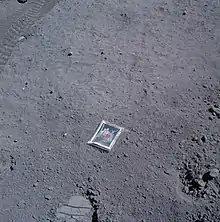
On the way back to Earth, Duke assisted in a deep-space EVA that lasted 1 hour and 23 minutes, when Mattingly climbed out of the Casper spacecraft and retrieved film cassettes from the service module. After a journey during which Casper had traveled 2,238,598 kilometers (1,208,746 nmi), the Apollo 16 mission concluded with a splashdown in the Pacific Ocean at 19:45:05 UTC on April 27, and recovery by the aircraft carrier USS Ticonderoga.[85]
Duke left two items on the Moon, both of which he photographed. The most famous is a plastic-encased photo portrait of his family taken by NASA photographer Ludy Benjamin. The reverse of the photo was signed and thumb printed by Duke's family and bore this message: "This is the family of Astronaut Duke from Planet Earth, who landed on the Moon on the twentieth of April 1972."[86]
The other item was a commemorative medal issued by the Air Force, which was celebrating its 25th anniversary in 1972. Duke was the only Air Force officer to visit the Moon that year. With the approval of the Chief of Staff of the United States Air Force, General John D. Ryan, and the Secretary of the Air Force, Robert Seamans, Duke took two silver medallions commemorating the anniversary. He left one on the Moon and donated the other to the Air Force.[86] Today it is on display at the National Museum of the United States Air Force at Wright-Patterson Air Force Base in Dayton, Ohio, along with a Moon rock from the Apollo 16 mission.[87]
In the wake of the Apollo 15 postal covers scandal, Slayton replaced the Apollo 15 crew as the backup for the Apollo 17 mission with the Apollo 16 one.[88] Duke became the backup LMP, Young the backup commander, and Roosa the backup CMP. They went into training again in June 1972, just two months after Duke and Young had returned from the Moon. There was only a slim chance that they would be called upon to fly the mission, and in the event were not. Duke never flew in space again.[89] He retired from NASA on January 1, 1976. He had spent 265 hours and 51 minutes in space.[81]
Later life
Following his retirement from NASA, Duke left active duty in the USAF as a colonel, and entered the Air Force Reserve. He served as Mobilization Augmentee to the Commander, Air Force Basic Military Training Center and to the Commander, USAF Recruiting Service.[90] He graduated from the Industrial College of the Armed Forces in 1978 and was promoted to brigadier general the following year.[91] He retired in June 1986.[92] He has logged 4,147 hours of flying time, of which 3,632 hours was in jet aircraft.[82]
Duke had always been fond of Coors Beer, which was only available in Texas around Dallas and El Paso at the time. In 1975, he heard that the company was thinking of expanding into the rest of Texas. He formed a partnership with former Olympic basketball player Dick Boushka, and they drew up a business plan and put in a bid for the new Coors distributorship in Austin. Coors declined their bid, but offered the distributorship in San Antonio instead, which they accepted.[93][94] The house in El Lago was sold, and Duke and his family moved to New Braunfels, a community not far from San Antonio,[95] where, as of December 2019, he and wife Dotty remain.[96] His brother Bill died in 2011.[97]
The Coors distributorship was very successful, but Duke became bored and frustrated with it, and decided to sell in February 1978. He and Boushka realized a handsome profit from what had become a thriving business. He joined a friend, Ken Campbell, in real estate ventures.[98] His subsequent business ventures include being president of the Orbit Corporation from 1976 to 1978; director of the Robbins Company from 1986 to 1989 and Amherst Fiber Optics in 2000; chairman of Duke Resources from 1988 to 1993 and Texcor from 1989 to 1994, and of the Astronaut Scholarship Foundation from 2011 to 2012. He was also a consultant for Lockheed Martin.[91]
Since 1978, Duke has been a committed born-again Christian. He wrote in his book that his temper, ego, single-minded devotion to work, and greed had ruined his relationship with his wife and his children, and his marriage teetered on the verge of divorce in the late 1960s and early 1970s. Dotty suffered from depression and considered suicide. Duke and Dotty, who became a Christian before him, credit God with making their lives much more complete and joyful. Duke stated that his marriage and his relationship with his children improved considerably after he committed his life to Jesus. [99] He is active in Christian ministry. [100]
Awards and honors
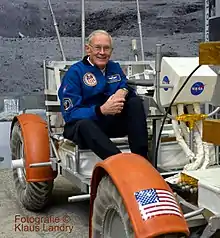
In 1973, Duke received an Honorary Doctorate of Philosophy from the University of South Carolina, an Honorary Doctorate of Humanities from Francis Marion University in 1990,[82] and an Honorary Doctorate in Philosophy from Clemson University in 2012.[101] Other honors include the NASA Distinguished Service Medal in 1972,[102] Manned Spacecraft Center Certificate of Commendation in 1970, the Air Force Distinguished Service Medal with Oak leaf cluster, the Legion of Merit, Society of Experimental Test Pilots' Iven C. Kincheloe Award in 1972, American Astronautical Society Flight Achievement Award for 1972, American Institute of Aeronautics and Astronautics' Haley Astronautics Award for 1973, Fédération Aéronautique Internationale V. M. Komarov Diploma in 1973, and the Boy Scouts of America Distinguished Eagle Scout Award in 1975.[82] International Olympic Committee President Thomas Bach presented the Sky is the Limit Trophy to Duke in 2018.[103]
Duke was named South Carolina Man of the Year in 1973,[82] inducted into the South Carolina Hall of Fame in 1973, and the International Space Hall of Fame in 1983.[104] He was one of 24 Apollo astronauts who were inducted into the U.S. Astronaut Hall of Fame in 1997.[105][106] He was inducted into the Texas Science Hall of Fame in 2000,[107] and the National Aviation Hall of Fame in 2019.[108] His name is inscribed on The Astronaut Monument in Iceland, where they conducted some of their geological training.[109] In December 2019 was named Texan of the Year for 2020.[107] Asteroid 26382 Charlieduke was named in his honor. The official naming citation was published by the Minor Planet Center on May 18, 2019.[110]
Cultural depictions
Duke was the subject of the documentary Lunar Tribute, which premiered at the American Museum of Natural History's Hayden Planetarium on October 20, 2017. At a panel after the screening, Neil deGrasse Tyson noted that Duke was the youngest person to walk on the Moon. Duke responded that at age 82, he still was.[111] He joined the Back to Space organization in 2018 as an Astronaut Consultant with the goal of inspiring through film the next generation to go to Mars.[112] He was featured prominently in the BBC World Service Podcast, 13 Minutes to the Moon, released in 2019 to mark 50 years since the Apollo 11 mission.[113]
In 2018, country music duo The Stryker Brothers released the song "Charlie Duke Took Country Music To The Moon," which tells the true story of how Duke brought two audio cassette tapes of country music to play during the Apollo 16 mission.[114] Duke's friend Bill Bailey, a disc jockey at Houston-area country music radio station KIKK, had enlisted several country stars of the time to provide personalized recordings for the astronauts. The tapes were introduced by Merle Haggard, and other artists included Porter Wagoner, Dolly Parton, Buck Owens, Jerry Reed, Chet Atkins, and Floyd Cramer.[114][115][116]
"The Stryker Brothers" was the stage name for a collaboration between Robert Earl Keen and Randy Rogers, but the two initially kept their identities secret, with promotional material claiming that the music originated from two actual brothers who had died in a prison fire.[114] Duke appeared in an online video asserting that he got to know the brothers as children at the home of disc jockey Bailey, and that he gave them a copy of the tapes following his return from the Moon.[117] In reality, Duke met Rogers at an event in New Braunfels, where both men live.[114]
Notes
- "Charles Moss Duke Jr". The New York Times. April 17, 1972. p. 24. Retrieved December 7, 2019.
- Shayler & Burgess 2017, p. 38.
- Duke & Duke 1990, pp. 22–23.
- "Obituaries: Willie Duke, Homemaker". The Charlotte Observer. Charlotte, North Carolina. April 17, 1995. p. 2Y. Retrieved April 17, 2020 – via Newspapers.com.
- Duke & Duke 1990, p. 25.
- Dys, Andrew (October 24, 2008). "Lancaster's Future, Like Its Past, Is in the Stars". Rock Hill Herald. Rock Hill, South Carolina. Retrieved January 28, 2020.
- Duke & Duke 1990, p. 26.
- Duke & Duke 1990, p. 24.
- Townley 2009, p. 79.
- "Distinguished Eagle Scouts" (PDF). Boy Scouts of America. Archived from the original (PDF) on March 12, 2016. Retrieved November 4, 2010.
- Duke & Duke 1990, pp. 26–27.
- Duke & Duke 1990, pp. 31–34.
- Duke & Duke 1990, pp. 34–39.
- Duke & Duke 1990, pp. 40–45.
- "Airplanes, Sensation of Flight Always an Attraction to Astronaut Charles Duke". Manitowoc Herald-Times. Manitowoc, Wisconsin. April 12, 1972. p. 10. Retrieved December 14, 2019 – via Newspapers.com.
- Duke & Duke 1990, pp. 56–59.
- "Dotty and Charlie Duke". Duke Ministry For Christ. Retrieved December 8, 2019.
- Duke & Duke 1990, pp. 61–63.
- Duke & Duke 1990, pp. 64–65.
- Duke & Duke 1990, pp. 65–66.
- Shayler & Burgess 2017, p. 62.
- Duke & Duke 1990, p. 73.
- Duke & Duke 1990, p. 72.
- Shayler & Burgess 2017, p. 10.
- Duke & Duke 1990, pp. 74–75.
- Shayler & Burgess 2017, pp. 13–15.
- Shayler & Burgess 2017, p. 23.
- Shayler & Burgess 2017, pp. 17–19.
- Duke & Duke 1990, p. 76.
- Collins 2001, pp. 179–181.
- Thompson, Ronald (April 5, 1966). "19 New Spacemen Are Named". The High Point Enterprise. High Point, North Carolina. p. 2A – via Newspapers.com.
- Collins 2001, p. 181.
- Duke & Duke 1990, pp. 90–91.
- Duke & Duke 1990, p. 99.
- Shayler & Burgess 2007, pp. 105–107.
- Shayler & Burgess 2007, pp. 103–105.
- Shayler & Burgess 2007, pp. 109–111.
- Shayler & Burgess 2017, p. 156.
- Shayler & Burgess 2017, p. 157.
- Hacker & Grimwood 1974, pp. 528–529.
- Duke & Duke 1990, p. 95.
- Shayler & Burgess 2017, pp. 157–158.
- Duke, Charles (March 12, 1999). "Charles M. Duke, Jr. Oral History" (Interview). Interviewed by Doug Ward. NASA. Retrieved December 8, 2019.
- Brooks, Grimwood & Swenson 1979, pp. 200–201.
- Brooks, Grimwood & Swenson 1979, pp. 244–245.
- Brooks, Grimwood & Swenson 1979, p. 302.
- Brooks, Grimwood & Swenson 1979, p. 261.
- Orloff 2000, p. 72.
- Cernan & Davis 2000, pp. 228–230.
- Slayton & Cassutt 1994, pp. 237–238.
- Stafford & Cassutt 2002, pp. 135–136.
- Duke & Duke 1990, p. 115.
- Brooks, Grimwood & Swenson 1979, p. 305.
- Duke & Duke 1990, pp. 116–118.
- Brooks, Grimwood & Swenson 1979, pp. 223, 306.
- Orloff 2000, p. 268.
- Jones, Eric. "ALSEP Off-load". Apollo 16 Lunar Surface Journal. NASA. Retrieved December 11, 2019.
- "Apollo 16 Prime and Backup Crews" (PDF) (Press release). NASA. March 3, 1971. MSC 71-09. Retrieved December 11, 2019.
- Brooks, Grimwood & Swenson 1979, p. 244.
- Harland 1999, pp. 179–180.
- Duke & Duke 1990, pp. 138–142.
- "LM Pilot Charles M. Duke Hospitalized" (PDF) (Press release). NASA. January 4, 1972. MSC 72-02. Retrieved December 11, 2019.
- Orloff 2000, p. 229.
- "Apollo 16 Mission Rescheduled" (PDF) (Press release). NASA. January 7, 1972. Retrieved December 11, 2019.
- Woods, David; Brandt, Tim. "Apollo 16: Day 1 Part One". Apollo 16 Flight Journal. NASA. Retrieved December 11, 2019.
- Benson & Faherty 1978, pp. 518–519.
- "Leak Develops in Apollo 16 Fuel System" (PDF) (Press release). NASA. January 25, 1972. Retrieved December 11, 2019.
- Slayton & Cassutt 1994, p. 276.
- Duke & Duke 1990, pp. 151–152.
- Orloff 2000, p. 213.
- Fierro 2005, p. 24.
- Woods, David; Brandt, Tim. "Apollo 16: Day One Part Three: Second Earth Orbit and Translunar Injection". Apollo 16 Flight Journal. NASA. Retrieved December 12, 2019.
- Duke & Duke 1990, pp. 153–154.
- Mission Evaluation Team 1972, pp. 14-45–14-48.
- Woods, David; Brandt, Tim. "Apollo 16: Day Five Part Two: Lunar Module Undocking and Descent Preparation; Revs 11 and 12". Apollo 16 Flight Journal. NASA. Retrieved December 12, 2019.
- Duke & Duke 1990, pp. 157–158.
- Woods, David; Brandt, Tim. "Apollo 16: Day Five Part Four: Rendezvous and Waiting. Revs 13 to 15". Apollo 16 Flight Journal. NASA. Retrieved December 12, 2019.
- Woods, David; Brandt, Tim. "Apollo 16: Day Five Part Five – Clearance for PDI – Again – and Landing, Revs 15 and 16". Apollo 16 Flight Journal. NASA. Retrieved December 12, 2019.
- Orloff 2000, p. 216.
- "South Carolinan Scheduled to Be Tenth Man to Walk on the Moon". The Greenville News. Greenville, South Carolina. March 5, 1972. p. 1-D. Retrieved December 14, 2019 – via Newpapers.com.
- "Astronaut Duke to Leave NASA" (PDF) (Press release). MSC 75-74. Retrieved December 10, 2019.
- "Astronaut Bio: Charles Duke". NASA Johnson Space Center. May 1994. Archived from the original on December 17, 2016. Retrieved July 17, 2013.
- Duke & Duke 1990, pp. 206–207.
- "EVA-3 Closeout". Apollo 16 Lunar Surface Journal. NASA. Retrieved December 11, 2019.
- Orloff 2000, pp. 224–225.
- Duke & Duke 1990, pp. 147–148.
- "Moon Rock". National Museum of the United States Air Force. Retrieved December 10, 2019.
- Slayton & Cassutt 1994, p. 279.
- Duke & Duke 1990, pp. 233–234.
- "Filling the Gap". The Air Reservist. XXXIV (5): 12. May–June 1982. ISSN 0002-2535. Retrieved April 15, 2020.
- "Professional Profile". Charlieduke.net. Archived from the original on August 21, 2012. Retrieved May 13, 2015.
- Shayler & Burgess 2017, p. 270.
- Duke & Duke 1990, pp. 238–239.
- Hurt III, Harry (March 1976). "Muscling in on Texas Beer". Texas Monthly. Vol. 4 no. 3. pp. 73–75, 84–85, 110–113. ISSN 0148-7736. Retrieved June 1, 2018.
- Duke & Duke 1990, p. 254.
- "Apollo 16 Moonwalker Is First Astronaut to be Named Texan of the Year". collectSPACE. Retrieved December 12, 2019.
- "Lancaster Astronaut Recalls Moon Landing on 40th Anniversary". WBTV News. April 20, 2012. Retrieved August 14, 2019.
- Duke & Duke 1990, pp. 256–257, 272–273.
- Duke & Duke 1990, pp. 239–243.
- "Video: Charlie Duke – Interviews with the Men on the Moon". The Daily Telegraph. London. July 17, 2009. Retrieved July 26, 2018.
- "Graduation Thursday December 20, 2012" (PDF). Clemson University. Retrieved December 14, 2019.
- Gawdiak & Fedor 1994, p. 399.
- "Astronaut Charles Duke Who Brought the Olympic Spirit to the Moon Honoured by the IOC – Olympic News". International Olympic Committee. December 13, 2018. Retrieved December 15, 2018.
- Sheppard, David (October 2, 1983). "Space Hall Inducts 14 Apollo Program Astronauts". El Paso Times. El Paso, Texas. p. 18 – via Newspapers.com.
- "Charlie Duke". Astronaut Scholarship Foundation. Retrieved May 13, 2015.
- Meyer, Marilyn (October 2, 1997). "Ceremony to Honor Astronauts". Florida Today. Cocoa, Florida. p. 2B – via Newspapers.com.
- "Apollo 16 moonwalker is first astronaut to be named Texan of the Year". collectSPACE. December 3, 2019. Retrieved December 3, 2019.
- "National Aviation Hall of Fame Reveals "Class of 2019"". National Aviation Hall of Fame. Retrieved December 14, 2019.
- Orlyson, Orly. "Apollo Astronauts Revisit Training Area in Iceland and Explore a New Lava Flow". The Exploration Museum. Archived from the original on April 2, 2019.
- "MPC/MPO/MPS Archive". Minor Planet Center. Retrieved June 3, 2019.
- Urrutia, Doris Elin (October 24, 2017). "New Film 'Lunar Tribute' Tells Moonwalker's Story with Drums". Space.com. Retrieved December 10, 2019.
- "Back To Space | The Team". Back To Space. February 5, 2018. Retrieved July 24, 2018.
- "BBC World Service – 13 Minutes to the Moon". BBC.
- Gage, Jeff (January 25, 2019). "Inside Robert Earl Keen, Randy Rogers' Fictional Stryker Brothers Duo". Rolling Stone. Retrieved July 24, 2019.
- Duke & Duke 1990, pp. 80–81.
- "Out of This World: What It's Really Like to Walk on the Moon". The Independent. London. October 23, 2007. Retrieved July 24, 2019.
- Stryker Brothers (August 28, 2018). #SearchForTheStrykers from Astronaut, Charlie Duke (Part One). YouTube. Retrieved July 24, 2019.
References
- Benson, Charles D.; Faherty, William Barnaby (1978). Moonport: A History of Apollo Launch Facilities and Operations (PDF). NASA History Series. Washington, DC: NASA. SP-4204. Retrieved December 11, 2019.
- Brooks, Courtney G.; Grimwood, James M.; Swenson, Loyd S. Jr. (1979). Chariots for Apollo: A History of Manned Lunar Spacecraft. NASA History Series. Washington, D.C.: Scientific and Technical Information Branch, NASA. ISBN 978-0-486-46756-6. LCCN 79001042. OCLC 4664449. SP-4205. Retrieved July 20, 2010.
- Cernan, Eugene; Davis, Don (2000). The Last Man on the Moon: Astronaut Eugene Cernan and America's Race in Space. New York: St. Martin's Press. ISBN 978-0-312-26351-5. LCCN 98048206. OCLC 45049476.
- Collins, Michael (2001) [1974]. Carrying the Fire: An Astronaut's Journeys. New York: Cooper Square Press. ISBN 978-0-8154-1028-7. OCLC 45755963.
- Duke, Charlie; Duke, Dottie (April 1990). Moonwalker. Nashville: Thomas Nelson Inc. ISBN 978-0-8407-9106-1. OCLC 20826452.
- Fierro, Pamela (2005). The Everything Twins, Triplets, and More Book: From Seeing the First Sonogram to Coordinating Nap Times and Feedings – All You Need To Enjoy Your Multiples. Avon, Massachusetts: Adams Media. ISBN 978-1-4405-2321-2.
- Gawdiak, Ihor; Fedor, Helen (1994). NASA Historical Databook, Volume IV: NASA Resources 1969–1978 (PDF). Washington, D.C.: NASA. SP-4012. Retrieved November 6, 2018.
- Hacker, Barton C.; Grimwood, James M. (September 1974). "Charting New Space Lanes". On the Shoulders of Titans: A History of Project Gemini. NASA History Series. NASA. OCLC 3821896. SP-4203. Archived from the original on January 13, 2010.
- Harland, David M. (1999). Exploring the Moon: the Apollo Expeditions. Chichester: Springer-Praxis. ISBN 1-85233-099-6. OCLC 982158259.
- Mission Evaluation Team (August 1972). Apollo 16 Mission Report (PDF). Houston, Texas: NASA. OCLC 565883045. MSC-07230. Retrieved December 12, 2019.
- Orloff, Richard W. (2000). Apollo by the Numbers: A Statistical Reference. NASA History Series. Washington, D.C.: NASA History Division, Office of Policy and Plans. ISBN 978-0-16-050631-4. LCCN 00061677. OCLC 829406439. SP-2000-4029. Retrieved June 12, 2013.
- Shayler, David J.; Burgess, Colin (2007). NASA's Scientist Astronauts. Chichester: Praxis Publishing. ISBN 978-0-387-21897-7. OCLC 1058309996.
- Shayler, David J.; Burgess, Colin (2017). The Last of NASA's Original Pilot Astronauts: Expanding vthe Space Frontier in the Late Sixties. Chichester: Springer-Praxis. ISBN 978-3-319-51012-5. OCLC 1023142024.
- Slayton, Donald K. "Deke"; Cassutt, Michael (1994). Deke! U.S. Manned Space: From Mercury to the Shuttle. New York: Forge (St. Martin's Press). ISBN 978-0-312-85503-1. OCLC 29845663.
- Stafford, Thomas; Cassutt, Michael (2002). We Have Capture. Washington, DC: Smithsonian Institution Press. ISBN 978-1-58834-070-2. OCLC 49558824.
- Townley, Alvin (2009). Legacy of Honor: The Values and Influence of America's Eagle Scouts. New York: St. Martin's Press. ISBN 978-0-312-36653-7. OCLC 266971032.
Further reading
- Brown, Mick (July 20, 2019). "'I've been there'". The Telegraph Magazine. London: Daily Telegraph. pp. 48–51, 53–4. OCLC 69022829.
- Chaikin, Andrew (1994). A Man on the Moon: The Voyages of the Apollo Astronauts. New York: Viking. ISBN 978-0-670-81446-6. LCCN 93048680. OCLC 29548704.
External links
| Wikimedia Commons has media related to Charlie Duke. |
- Charles Duke at IMDb
- Appearances on C-SPAN